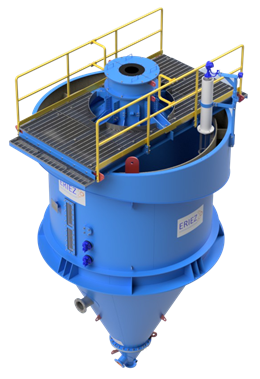
HydroFloat Flotation
HydroFloat Coarse Particle Flotation
The HydroFloat® recovers particles +2x coarser than conventional flotation cells, which allows for a shift in the economic optimum grind size, and in turn increases profitability and improves environmental sustainability of mining projects.
To meet society’s needs for critical mineral resources, the mining industry must develop projects that are socially accepted, environmentally sustainable, and economically profitable. One of the processes that have highest potential to overcome some of these challenges is Coarse Particle FlotationTM (CPF). Eriez has developed and patented the HydroFloat, an innovative fluidized-bed coarse particle flotation machine with demonstrated commercial success in base metals and industrial minerals applications for nearly 20 years.
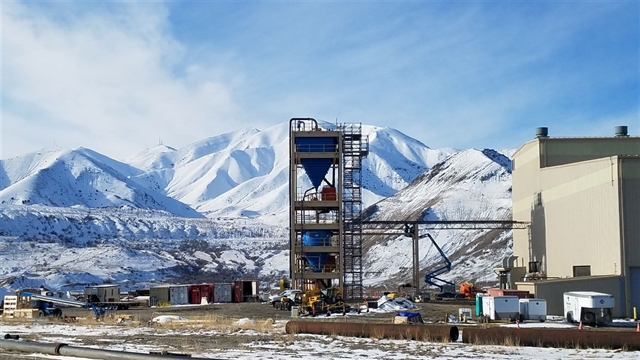
HydroFloat can be used to recover several types of minerals:
- Copper
- Gold
- Iron Ore
- PGM
- Phosphate
- Potash
- Lithium
- Polymetallic Ores (Pb/Zn/Cu)
- Others
The HydroFloat CPFTM has two main applications:
Tailings Scavenger (TS)
In Tailings Scavenger (TS) applications, the HydroFloat provides selective recovery of semi-liberated and fully-liberated minerals contained within the coarse size fraction of rougher flotation tailings, thus increasing global recovery.
For example, HydroFloat TS projects demonstrate that it is possible to increase global recovery of copper concentrator by 2% to 6%. In addition to that, some plants after the installation of HydroFloat cells could coarse the grinding product, allowing to increase the plant throughput, achieving similar or higher global recoveries than the conventional process.
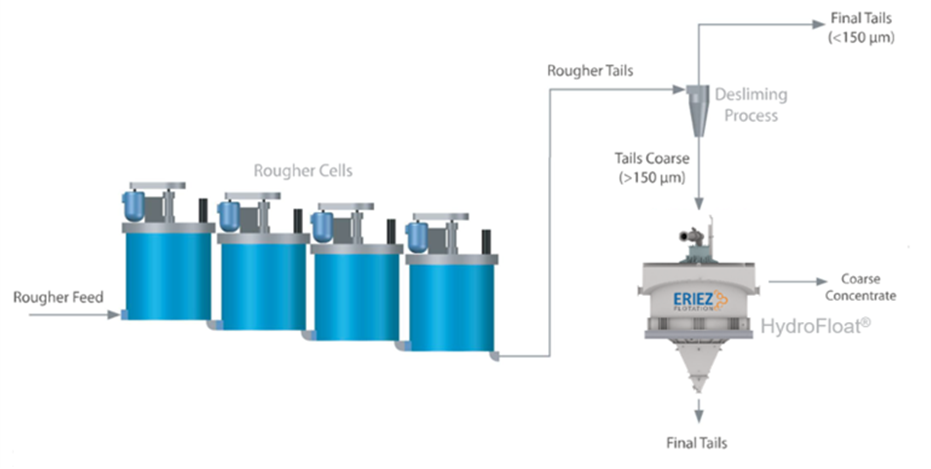
Figure 1. Simplified HydroFloat TS flowsheet
Coarse Gangue Rejection (CGR)
In CGR applications, the HydroFloat is installed in the grinding circuit. Here, the coarse size fraction of the secondary classification process (U/F) is fed to the HydroFloat. The tailings produced from the HydroFloat are final tailings, and this allows to remove approximately 30% to 40% wt/wt of the total gangue at coarse fractions (+400 µm) and in early stages of the process.
CGR applications will help to reduce the energy consumption in the ball mills in the range of 30% to 50% and produce coarse tailings that will facilitate the water recovery and tailings management.
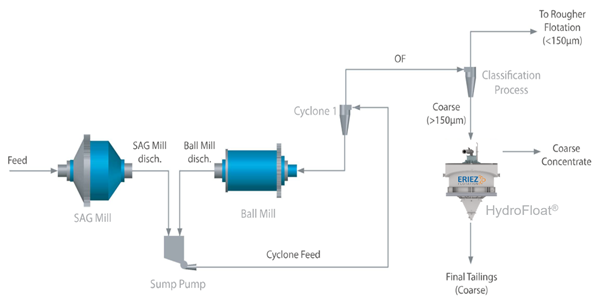
Figure 2. Simplified HydroFloat CGR flowsheet
HydroFloat CPF Advantages
Increases plant profitability by:
- Allowing an increase in plant throughput by 10% to 35% without the necessity of adding extra primary mills.
- Improving global plant recovery by 2% to 6% (Cu typical).
- Reducing total OPEX of greenfield projects by more than 10%.
- Enabling processing hard and lower grade ores at coarser fractions.
Improves environmental sustainability by:
- Increasing water recovery by 85% in combination with advanced dewatering processes.
- Reducing energy consumption by 10 to 20%.
- Producing +2x coarser tailings, optimizing tailings management, and facilitating safer tailings disposal (e.g., dry stacking, co-disposal).
Improves project economic KPIs by:
- Reducing total OPEX of greenfield projects by more than 10%.
- Improving overall NPV by 20% to 40% with only an additional 5% to 10% CAPEX investment.*
- Reducing conventional flotation circuit by 40%.*
*in greenfield project implementations
Increases Metallurgical Efficiency by:
- Improving global plant recovery by 2% to 6% (Cu typical).
- Removing between 30% to 45% of the total gangue at early stages of the process, and in coarse fractions (+400µm), improving residence time in the conventional circuit by 40%.
- Processing hard and lower grades ores at coarser fractions, improving plant production and profitability.
Product Features
The HydroFloat is a fluidized-bed coarse particle flotation machine that overcomes buoyancy and froth recovery restrictions through up-current water velocity and plug flow conditions.
HydroFloat technology is designed and built to last, with components and materials selected for maximum availability and operating life.
The HydroFloat requires very little maintenance (even treating very coarse material), since its design does not include any rotating or moving parts.
The main feature of the HydroFloat coarse particle flotation machine is a circular vessel comprised of an upper freeboard region, a central separation region and a lower dewatering cone. Classified and conditioned feed slurry is introduced to a feedwell within the upper freeboard region and settles against a rising mixture of water and fine air bubbles introduced and dispersed through a proprietary elutriation manifold with an external aeration system. Proprietary feedwell and elutriation manifold designs provide uniform distribution of feed, fluidization water, and air across the HydroFloat cross-sectional area, maximizing throughput and process efficiency.
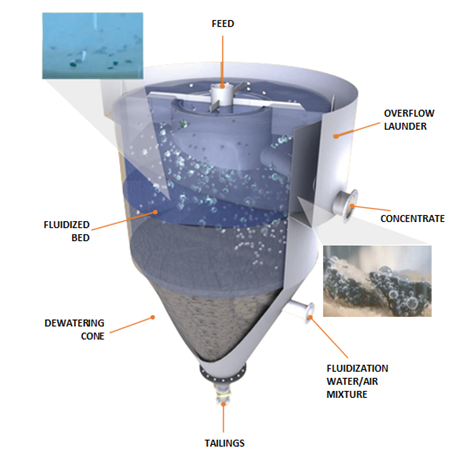
The upward flow of water and air creates a fluidized bed (or teeter bed) of suspended particles in the separation region with high interstitial liquid velocities that resist the penetration of slow settling particles. As air bubbles rise through the fluidized bed and into the freeboard region, they selectively attach to hydrophobic particle surfaces and produce bubble-particle agglomerates with a reduced effective density and increased buoyancy. As a result, particles with minimal hydrophobic surface exposure are very effectively recovered.
Expansion of the fluidized bed is controlled to alter the effective bed density, thus preventing lower density bubble-particle agglomerates in the freeboard region from penetrating the fluidized bed and reporting to the underflow. It has been consistently observed that only a single air bubble attachment site is adequate to prevent coarse particles from penetrating the fluidized bed. This theoretically provides infinite residence time for attachment of additional air bubbles at other hydrophobic exposure sites and/or bridging together of multiple bubble-particle agglomerates until the particles are carried over to the overflow launder due to the increased buoyancy force. Due to the constant overflow of fluidization water, no froth phase is developed and thus froth recovery challenges are eliminated.
Hydrophilic particles that do not attach to the air bubbles (i.e., gangue) continue to move down through the fluidized bed, settle into the dewatering cone, and discharged at high percent solids (e.g. 55-65% wt/wt) through the use of an underflow control valve.
Proprietary control systems for fluidization water, flotation air, pre-aeration water, bed density, and bed level optimize the HydroFloat’s metallurgical performance.
The HydroFloat has been successfully commercialized for efficient flotation recovery of +2x coarser particles in comparison to conventional flotation technologies in a wide range of base metal and industrial mineral applications.
In the HydroFloat, coarse particle recovery is improved by:
- Increased bubble/particle collision rates
- Increased bubble/particle sliding time
- Increased residence time
- Decreased mixing
- Decreased turbulence and detachment
- Decreased buoyancy restrictions
Product Line
Various standard cell sizes available to fit a wide range of mineral applications and duties.
HydroFloat naming convention identifies the equivalent nominal feed capacity tons per hour (dry basis) for each HydroFloat unit. For example, a model HydroFloat CPF-300 provides a minimum feed capacity of 300 t/h. For all specific applications and ore types, Eriez experts prepare detailed simulations and precise sizing based on testing and operational data base.
HydroFloat Product Line Summary:
| Model | Dimensions(1) (mm) |
"Feed Capacity(2) (t/h)" |
|---|---|---|
| HydroFloat® CPF-40 | 1800 |
40 |
| HydroFloat® CPF-70 | 2400 | 70 |
| HydroFloat® CPF-100 | 3050 | 100 |
| HydroFloat® CPF-130 | 3300 | 130 |
| HydroFloat® CPF-150 | 3650 | 150 |
| HydroFloat® CPF-200 | 4250 | 200 |
| HydroFloat® CPF-300 | 5000 | 300 |
Installations
With more than 70 units operating in world-class mining jurisdictions in Australia, North America, South America & South Africa, HydroFloat CPF is proven to provide enhanced metallurgical performance and improve profitability and environmentally sustainability of mining projects. Please contact your local Eriez Representative for an up to date HydroFloat Installation List.
Eriez Flotation HydroFloat Coarse Particle Flotation (CPF) Technology
CEEC Spotlight Leader Conversations : Eric Wasmund - Eriez VP Global Flotation
Eriez HydroFloat® Coarse Particle Flotation - South American Copper Project (Shipment)
Eriez HydroFloat® Coarse Particle Flotation - South American Copper Project (Fabrication)
 Downloadable Documents
Downloadable Documents
The first in fluidized-bed flotation - Eriez has designed the HydroFloat Separator for coarse particle mineral concentration delivering the capacity of a density separator while maintaining the selectivity of a flotation device. Using a novel aeration system to disperse fine bubbles into a fluidized-bed environment, the HydroFloat Separator significantly increases the selective recovery of coarse particles by applying flotation fundamentals to gravity separation.
History of Coarse Particle Flotation and the Eriez HydroFloat®
The advent of fluidized-bed flotation began innocuously with a visit By Michael J. Mankosa, Ph.D. to a coal preparation facility in which a teeter-bed separator (TBS) was employed for the density separation of valuable coal from high-gravity refuse. During this plant visit, at a time when the facility was idle,some misplaced coarse coal was observed sitting on top of the fluidized bed.
Pioneering Coarse Particle Flotation
The Cadia mine, – owned by Newmont – has been successfully operating coarse particle flotation (CPF) at full scale for over 5 years.Effective recovery of particles has been proven with as little as 5% surface liberation of sulphide versus >20% for conventional tank cell flotation.
New approaches in gold recovery
Much of the world’s gold is in the form of free-milling and alluvial gold. Gold has a high density, about 20 times higher than water, which means that free gold can be economically recovered by a myriad of gravity processes such as jigs, tables, sluices, and centrifugal devices. It is generally accepted that the size of such particles should be greater than several hundred microns to be efficient.
Implementation of the HydroFloat Technology at the South Ford Meade Mine
Several industrial-scale HydroFloat separators have recently been installed at Mosaic’s South Fort Meade beneficiation plant for the purpose of improving phosphate recovery and throughput capacity.
Coarse gold recovery using flotation in a fluidized bed
A number of technologies are in practice for selectively removing coarse gold from conventional grinding circuits. These circuits are often designed so that the grinding mill output is size classified, with large (or high density) particles being removed before the tails are returned to the mill.
Flotation technology for coarse and fine particle recovery
This paper will discuss some of the current challenges associated with conventional froth flotation equipment, as well as solutions that can have a major impact on the industry world-wide.
Recovery of mineralized coarse particles is notoriously low in conventional concentrators that treat copper porphyry ores. The application of coarse particle flotation techniques has the potential to achieve comparable metallurgical performance at significantly coarser primary grind sizings.
Recovery of Values from A Porphory Copper Tailings Stream
The efficiency of the froth flotation process has long been known to be strongly dependent on particle size. For sulfide minerals, good recoveries are typically achieved in industrial flotation circuits for particles in the 30 to 150 μm size range. Particles outside this critical size are typically lost in industrial operations and rejected to tailings streams due to inherent constraints associated with the physical interactions that occur in the pulp and froth phases of conventional flotation equipment.
Significance of exposed grain surface area in coarse particle flotation of low-grade gold ore with the HydroFloat technology.Conventional flotation machines are typically limited to a particle topsize of 150-200 microns due to inherent constraints created by the pulp and froth phases. To overcome these limitations, a novel fluidized-bed flotation system called the HydroFloatTM Separator has been developed specifically for the purpose of floating coarse particles containing only small amounts of exposed hydrophobic minerals.
IMPC Reseach Paper - Split-Feed
Split-Feed circuit design for primary sulfide recovery. In this article, a split-feed circuit is described that utilizes two stages of classifying cyclones in conjunction with the HydroFloat separator. The HydroFloat is an innovative fluidized-bed separator that can substantially increase the upper particle size that can be successfully treated by flotation.
Conference of Metallurgists (COM), 2020
A comparison of two circuit applications for implementation of coarse particle flotation

